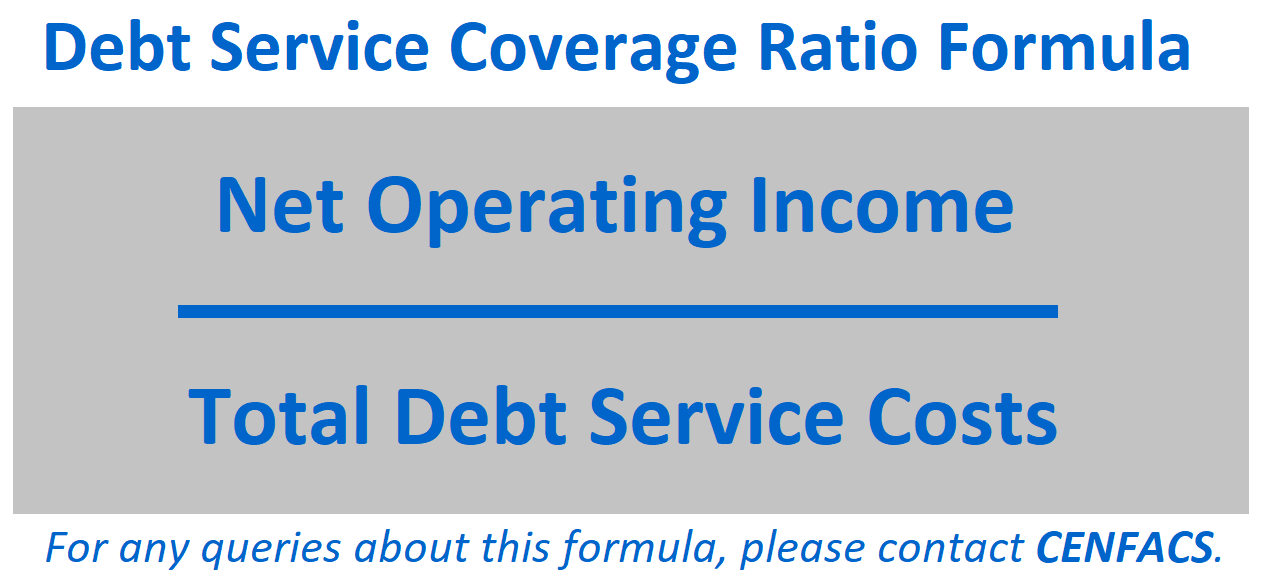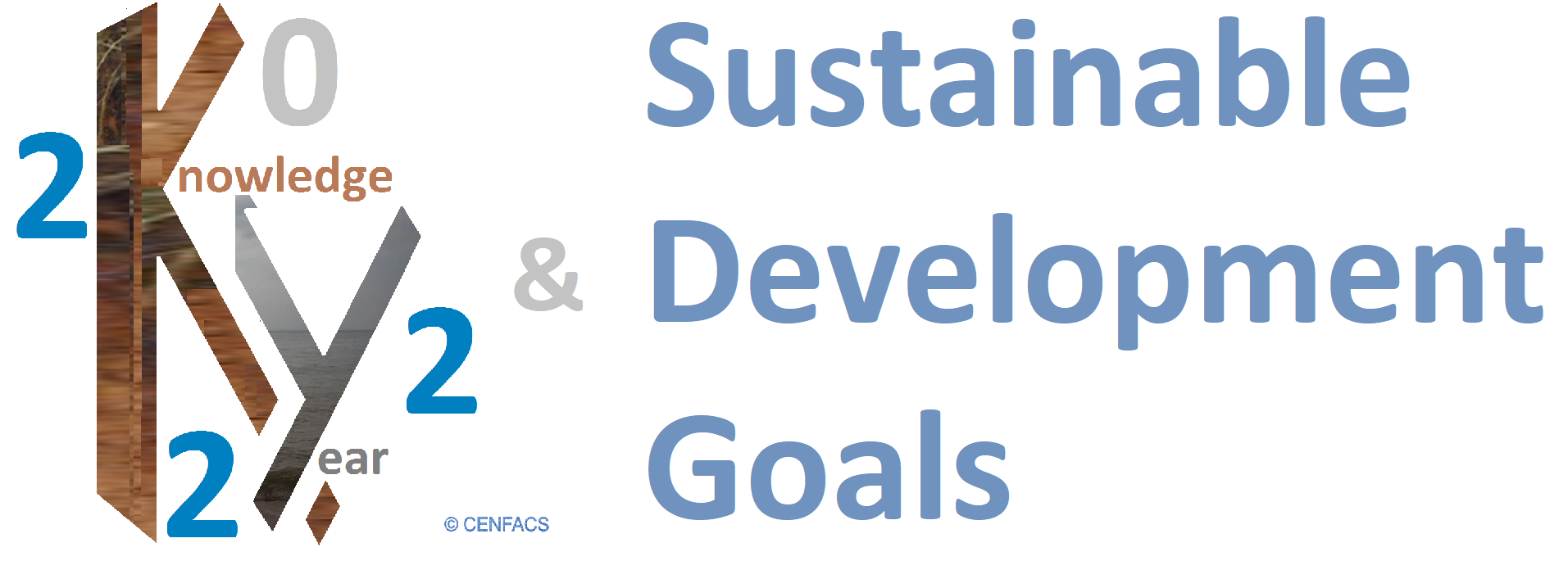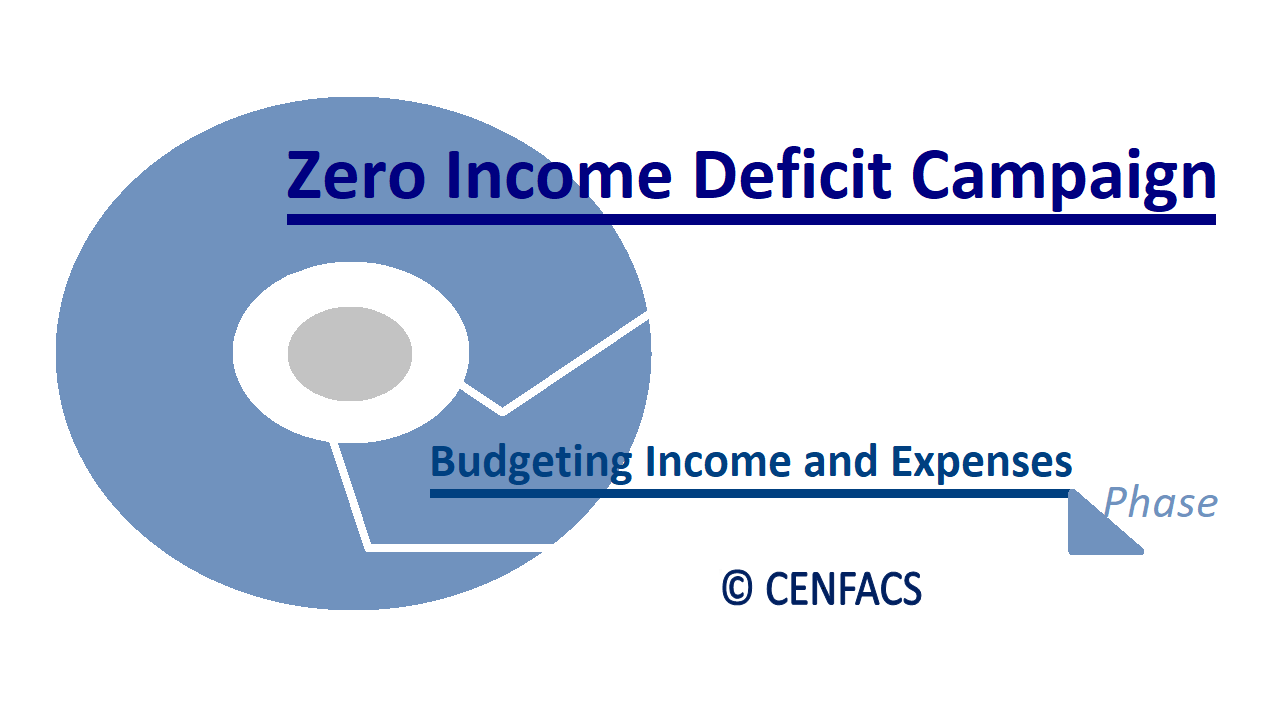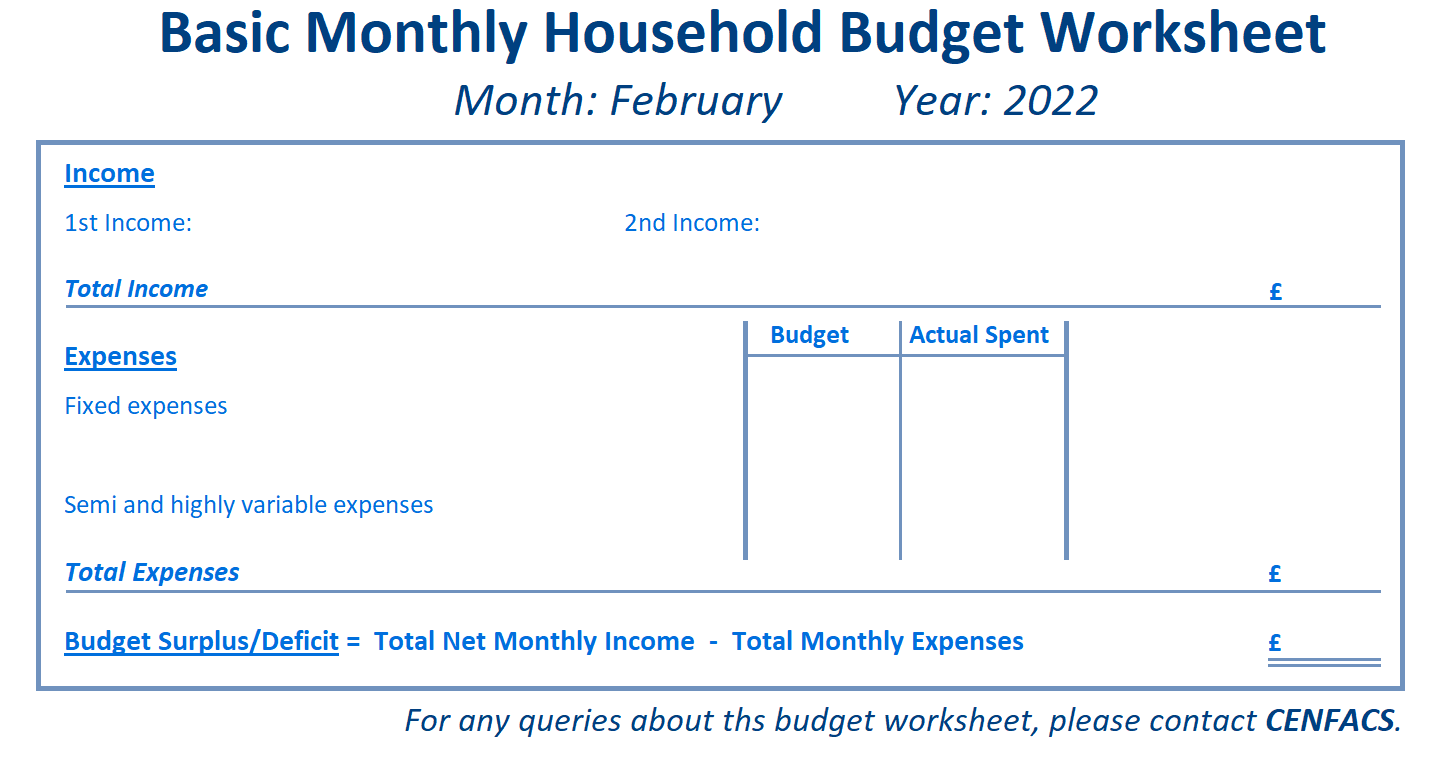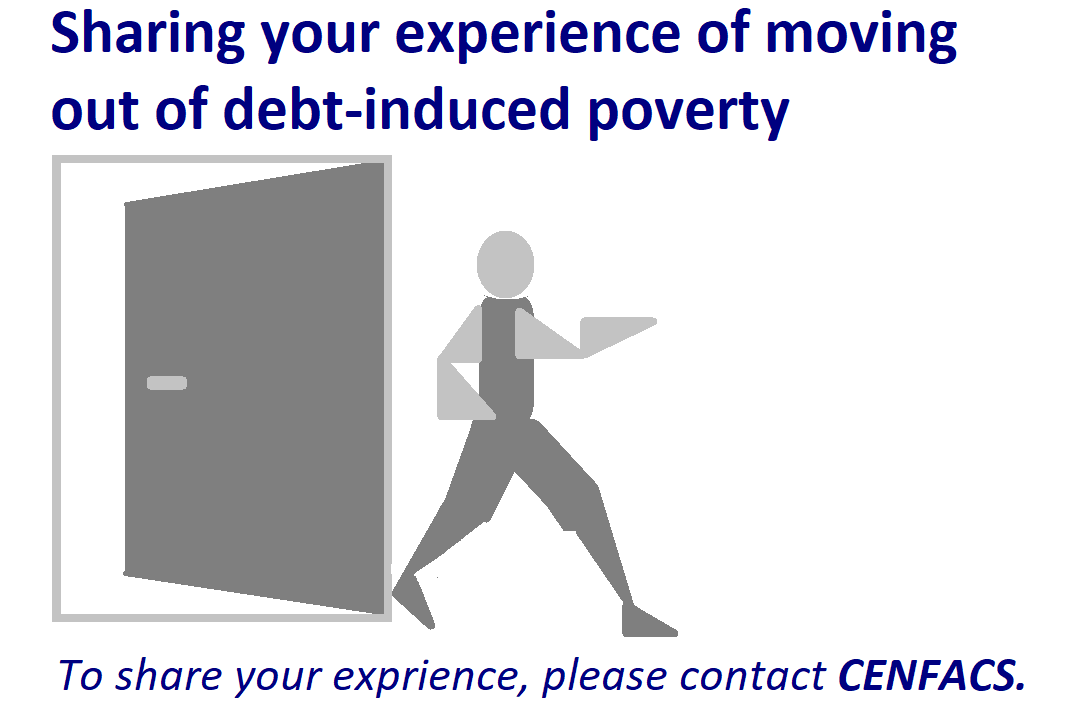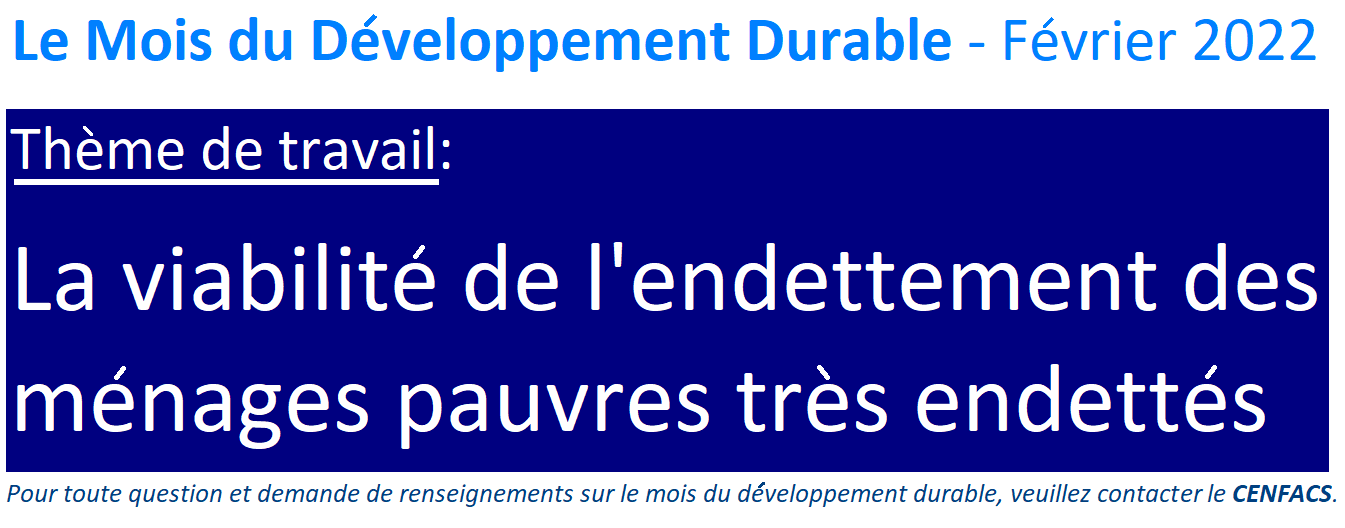Welcome to CENFACS’ Online Diary!
09 February 2022
Post No. 234
The Week’s Contents
• Debt Relief for the Highly Indebted Poor Households
• Activity/Task 2 of the Knowledge (K) Project: Knowledge about How Those in Need are Meeting Sustainable Development Goals
• Zero Income Deficit Campaign: Household Budget
… And much more!
Key Messages
• Second Wednesday (09/02/2022), In Focus: Debt Relief for the Highly Indebted Poor Households
Our Month of Sustainable Development continues with the sub-theme of Debt Relief for the Highly Indebted Poor Households.
Debt Relief for the Highly Indebted Poor Countries is part of the United Nations (1) Sustainable Development Goal 17 and Target 4 for poor countries. Debt of these countries may need to be relieved since the World Bank Group (2) estimated that
“Countries in Sub-Saharan Africa recorded the highest increase in external debt stocks in 2020, on average 10.7 per cent” (p. 10)
Although this data does not include domestic debt, it still matters from the perspective of debt relief since the populations of these indebted Sub-Saharan African countries are the ones to pay this mounting external debt.
Because countries are made with people and households, we are looking at debt relief at the household or people level rather than at the public or national level.
We are dealing with Debt Relief for the Highly Indebted Poor Households (HIPHs), particularly those household members of our community and members of sister communities who may be highly indebted poor and who need some advice, guidance and leads to debt relief support services. Our work with and support to them does not replace or reduce any assistance they may have somewhere else. Instead, it reinforces it.
In addition, debt relief support services should not be an end to themselves. Instead, they should lead to poverty reduction and to the improvement of the quality of life for debtors.
So, the key message here is HIPHs need their debts to be remitted or relieved if one wants to see them not living or going deeper in poverty. This remission or relief could be total or partial, and it has to make a helpful difference to them.
To get the full grips with this first message, please read under the Main Development section of this post.
• Activity/Task 2 of the Knowledge (K) Project: Knowledge about How Those in Need are Meeting Sustainable Development Goals
In the process of localisation of sustainable development goals, it is interesting to find out how local people with whom CENFACS work with are doing in terms of the realisation of these goals. This interest is also felt when one is trying to know and learn about the needs of those in need.
In the context of the ‘K‘ Project, we are trying to know the real needs of those suffering from all sorts of poverty so that their problems could be better identified, understood, unveiled and addressed in appropriate and efficient manner.
For example, the coronavirus pandemic has made the meeting of poor people’s needs very difficult and in some situations even impossible. In that difficulty or impossibility, the prospect for realising the United Nations Sustainable Development Goals has become distant.
So, knowing whether or not poor people are meeting needs and moving towards the realisation of sustainable development goals is an interesting issue. This month, we are working to know if our members are meeting or failing to meet sustainable development goals.
However, we are not going to limit ourselves to the knowledge of their needs. This is because knowing their realisation or failure is one thing. Doing something to support them if they are failing is much better and it is on the agenda.
For those members of our community who would like us to be aware of their needs and or who are failing to meet sustainable development goals, they can get in touch so that together we can work through the ‘K‘ Project and help them to navigate their way out of their problems.
• Zero Income Deficit Campaign: Household Budget
The next phase of our work about Zero Income Deficit Campaign is to work with users on budgeting of their income and expenses. This work is done in conjunction with our work on balance sheet and cash flow. The following summarises what we will be doing.
• • What is budgeting work with users?
It is about dealing with the process of preparing households’ or users’ financial plan for a given future period, which could be a month, a quarter, a semester, a year or any other period that users may want us to work with them. This financial plan, which is expressed in quantitative and financial terms, will include income forecasts and planned expenses for households/users who will work with us, like in any budgeting process.
• • What we hope to achieve
Through this process, it is hoped that households and users will be able to achieve the following:
√ To clarify financial responsibilities within their households
√ To coordinate household functions
√ To improve management and control of their resources
√ To correct or fix any potential problems due to bad or poor budgeting within their households
Etc.
• • Budgeting with users as an extra help and support
There are, on the market, many organisations offering budgeting recipes (online, in print and in-person). However, not all our users can understand or feel comfortable with budgetary jargon and processes; just like not everybody feels good at dealing with numbers, tables and charts.
For those members of our community who cannot deal with budgeting process by themselves or who have no time to budget their resources and may need extra help and support with their budgets, they can feel free to contact CENFACS.
CENFACS can work with them on income forecasting and expenses planning. We can as well work out their budget surplus or deficit depending on how their accounts look like on a monthly or quarterly or six-monthly or yearly basis.
To ask for extra help and support about budgeting your income and expenses, please contact CENFACS.
Extra Messages
• African Children’s Climate and Sustainable Development Goals (Generation Global Goals Project): Generational Impact Analysis of COVID-19 and its Variants on Children
Second round work about the generational effects of COVID-19 and its variants on children regarding the realisation of Sustainable Development Goals (SDGs)
It is without doubt to argue that COVID-19 has left and will leave some scars and fractures in the realisation of SDGs, particularly but not exclusively those aspects of these goals relating to children. The study on the following six selected SDGs will help to speculate on how COVID-19 is impacting or can impact the realisation of SDGs for children (particularly but not exclusively African children).
• • Summaries of possible generational effects of COVID-19 and its variants on children regarding the realisation of SDGs
Let us broadly consider the six selected goals (Goal 7 to 12) out of 17 United Nations SDGs for dealing with the COVID-19 effects.
Goal 7: Ensure access to affordable, reliable, sustainable and modern energy for all
The soaring price of energy (e.g. electricity and gas) combined with the prospect for phasing down coal as source of energy can only have adverse impacts for those African children who are poor and coal-dependant. These children may not have the means to transition to carbon net zero or post-carbon economy (that is; from polluting to clean and green energy and technology) if the pledges made to developing countries do not materialise.
In these circumstances, the Goal of ensuring access to affordable, reliable, sustainable and modern energy for all; may not materialise by its initial deadline.
Goal 8: Promote sustained, inclusive and sustainable economic growth, full and productive employment and decent work for all
Parents of poor children working in non essential economy suffered a big loss of jobs as a result of COVID-19 lockdowns. Many informal and casual workers as well as traders experienced an unprecedented cut in activities, jobs and earnings. The lingering effects of COVID-19 on jobs and earnings in terms of cuts are still felt until today. These huge cuts could only adversely impact children of these workers.
Thus, promoting sustained, inclusive and sustainable economic growth, full and productive employment and decent work for all; is still a distant prospect for COVID-19 induced poor and unemployed parents. Their children may not have the chance to realise some of the targets within Goal 8, let alone the realisation of other SDGs and targets by 2030.
Goal 9: Build resilient infrastructure, promote inclusive and sustainable industrialization and foster innovation
COVID-19 has displayed the weaknesses and lack of critical infrastructures for poverty reduction to help children from poor families to come out poverty, let alone to embrace sustainable development. For example, urban poor children in many large cities of Africa do not have access to resilient infrastructure to secure safe drinking water, sanitation, healthcare, decent housing, etc.
The cost of building resilient infrastructure to meet international standards and human rights approach is beyond reach in over-indebted African countries because of COVID-19 recovery bills and debts.
Additionally, industrialisation is more than just building a plan or a factory. It involves harnessing social change and fabric in places stricken by the legacies of COVID-19 or other epidemics or wars or civil insecurity.
Therefore, it will take such a long time for African children to see the fruits of Goal 9 to materialise as long as the COVID-19 damaging effects linger in their daily lives.
Goal 10: Reduce inequality within and among countries
One of the generational adverse impacts to mention here is the uneven and asymmetrical distribution of the effects of COVID-19 and lockdowns. This generational adverse impact or inequality has been in education where in some places in Africa some generations of children could not attend in-person school or home school because of mandatory lockdowns.
They could not follow online lessons through devises because they have not got equipment at home such as computers, laptops, tablets, etc. This is let alone the digital divide they have been already experiencing compared to children who are digitally educated and wealthy. This uneven access to information and communication technology and digital infrastructure continues even at the time of COVID-19 variants.
Goal 11: Make cities and human settlements inclusive, safe, resilient and sustainable
Many urban cities of Africa are not inclusive, safe, resilient and sustainable for children of poor families. Urban poor children experience poor living conditions such as appalling overcrowding, contaminated water, poor or absent of sanitation, lack of services and the constant threat of floods, landslides or industrial pollution. They are exposed to severe environmental health risks. This is let alone exploitation, abuse and trafficking.
The astronomic COVID-19 recovery costs do not make things easy for many urban cities in Africa in order for them to make human settlements (including children making part of these settlements) inclusive, safe, resilient and sustainable.
Goal 12: Ensure sustainable consumption and production patterns
Ensure sustainable consumption and production patterns mean a move towards net zero consumption and production; that is consumption and production that do not add extra CO₂ emissions to the amount of greenhouse gases in the atmosphere. Net zero consumption and production are an effort that any of the members of the global community can make in order to help achieve the global goal of 1.5 degrees Celsius under the Paris Climate Treaty.
To move towards a net zero consumption and production trajectory, one needs to reduce the adverse generational impact of COVID-19 on children if one wants to take them through this trajectory. This is because COVID-19 crisis and the related lingering economic effects have reduced choices for many poor consumers and producers. The children of these poor consumers and producers are not exempted from these long-standing adverse COVID-19 induced economic effects.
We hope that the above summaries provide some ideas about the generational impact analysis of COVID-19 and its variants on children, particularly but not exclusively on African children.
For those who would like to know more about our findings from this second round work and the stories of poverty reduction happening in Africa from CENFACS’ Africa-based Sister Organisations working with children, they should not hesitate to contact CENFACS.
• Triple-value-initiative Start-up/Planning
In order to support those who have decided or may decide to engage with All-year Round Projects or Triple Value Initiatives, we are running start up sessions for each of them (i.e. Run, Play and Vote projects). What do we mean by running start up sessions for Run, Play and Vote projects?
• • Start up for Run, Play and Vote Projects
Start up for these projects is about working with whoever decides to execute the above mentioned projects to set the tone of their projects and expectations for themselves. It is also about setting realistic goals and working out the right methodology from the beginning to the end in their project journey. It includes better planning and management.
• • Phases of project planning and management
We are going to deal with different phases of project planning or start up from the idea (of running or playing or voting) to the initiative implementation, monitoring and evaluation.
Whether you want to run or play or vote; you need to undertake a basic project planning in terms of the way you want to do it. This basic project planning/start-up will include things like the following:
σ Aims (changes you plan to achieve)
σ Impact (a longer-term effects of your project)
σ Inputs (resources you will put into your initiative)
σ Monitoring (regularly and systematically collecting and recording information)
σ Outcomes (changes and effects that may happen from your initiative)
σ Indicators (measures or metrics that show you have achieved your planned outcomes)
σ Budget (income and expenses for your initiative)
Etc.
As we all know, not everybody can understand these different steps they need to navigate in order to make their initiative or project a success story. That is why we are offering this opportunity to those who would like to engage with the Triple Value Initiatives (Run, Play and Vote projects) to first talk to CENFACS so that we can together soften some of the hurdles they may encounter in their preparation and delivery.
For those who would like to discuss with CENFACS their Triple-value-initiative plans or proposals, they are welcome to contact CENFACS.
• Goal for the Month: Reduction of Debt-induced Poverty
We continue to work on the Twenty-twenties (2020s) Development Agenda and Poverty Reduction Programme. As part of working on this Agenda and Programme, every month we select a particular poverty reduction goal to focus on. This selection can come from either one of the stated goals of the 2020s Development Agenda and Poverty Reduction Programme or outside these stated goals.
For this February 2022, we have selected the Reduction of Debt-induced Poverty. What is Reduction of Debt-induced Poverty? What does its selection or focus imply?
• • Understanding the Reduction of Debt-induced Poverty
Debt-induced Poverty Reduction is any measure or initiative taken to decrease the state, caused by debt, of having no money and no material possessions or of having very little of them. Briefly, it is about lowering the state of lacking the minimum income to purchase the basic needs of life; state caused or exacerbated by the state of owing something.
• • Implications for selecting the goal for the month
After selecting the goal for the month, we focus our work and mind set on the selected goal by making sure that in our real life we apply it. We also expect our supporters to work on the same goal by supporting those who may be suffering for the type of poverty linked to the goal for the month we are talking about during the given month.
For further details on the goal of the month and its selection procedure, please contact CENFACS.
Plan de travail de février 2022 sur la viabilité de la dette
Le plan de travail suivant donne un aperçu de la manière dont nous allons à la fois mener à bien le Mois du Développement Durable et soutenir les ménages de la communauté sur la question de la viabilité de la dette.
À partir de chaque mercredi de ce mois, nous traiterons de chacun des quatre éléments de la cible 4 de l’Objectif de Développement Durable 17 des Nations Unies comme suit:
Mercredis/Dates Notes/Sous-thèmes
1er mercredi / 02/02/2022 : Financement par emprunt
2ème mercredi / 09/02/2022: Allégement de la dette
3ème mercredi / 16/02/2022: Restructuration de la dette
4ème mercredi / 23/02/2022: Réduction de surendettement
Notre travail portera sur les questions ci-dessus en relation avec la COVID-19 et la pauvreté en ce qui concerne les pauvres.
Pour plus de détails, veuillez contacter le CENFACS.
Main Development
• Second Wednesday (09/02/2022), In Focus: Debt Relief for the Highly Indebted Poor Households
To approach Debt Relief for the Highly Indebted Poor Households (HIPHs) and to prepare ourselves in the way we could support these households making our community, we have organised these notes as follows:
Concepts linked to debt relief, relationship between debt relief and poverty reduction, energy debt relief for HIPHs, debt relief assistance programmes and CENFACS‘ programme of work with the community on debt relief.
Let us look at these notes.
• • Key Concepts
There are two key concepts we would like to highlight in these notes, which are: debt relief and net present value of debt.
• • • Debt relief
The literature review about debt relief provides lots of definitions about it. After reviewing some of them, we have selected the definition provided by the website ‘lawinsider.com’ (3), which argues that
“Debt relief means the release of the outstanding debt. [It also] means the reduction of debt for consideration that is less than the face value of the debt”.
We have also chosen the definition of the website ‘financial-dictionary.thefreedictionary.com’ (4), which states that
“Debt relief is the forgiveness of a legal obligation, in whole or in part”.
There is something in common in the above two definitions, which is the need to remit what is owed by the debtor to the creditor. It is hoped that this remission would provide to the debtor or HIPHs a blast of oxygen or a breathing space. The larger is the relief, the bigger could be the breathing space. For HIPHs, they could see this relief of debt as a road to the reduction of poverty induced by debt.
Briefly, debt relief is a measure to partially or totally remit debts; measure that can lead to the reduction or refinancing of debts so that the debtor can find easy way to pay the creditor. To remit debts, there could be a need to arrange a plan or programme of action.
• • • Net present value of debt
In order to relieve debt, it helps to know its net present value. What is the net present value of debt?
According to the International Monetary Fund (5),
“The Net Present Value of Debt measures the actual financial burden on a country of various kinds of debt and allows a more meaningful comparison of debt burdens across low-income countries than the face value of debt. The Net Present Value of Debt is a measure that takes into account the degree of concessionary. It is defined as the sum of all future debt-service obligations (interest and principal) on existing debt, discounted at the market interest rate”.
Although the International Monetary Fund refers to countries in its definition, this definition can be extended to include micro-economic entities such as households. It can be referred to them if one can make the hypothesis that a country is a sum of households. In this respect, it makes sense to know the net present value of debts owed by households. In fact, debt statistics are sometimes presented in terms of debt per household or per capita or per head.
CORRELATIONS BETWEEN COVID-19 INDUCED DEBT AND COVID-19 INDUCED POVERTY
Is anyone doing some research work on the connections between COVID-19-induced debt and COVID-19-induced poverty?
If yes, please could you share your findings with CENFACS?
Thank you!
• • Relationship between debt relief and poverty reduction
Debt relief is a key to poverty reduction. As the website ‘arstechnica.com’ (6) explains this:
“Behavioural scientists have found that poverty and the debt that goes with it actually change people’s behaviour, including how they respond to monetary decisions”.
From the behavioural perspective, debt relief can induce significant changes. These changes can happen to HIPHs as well.
So, reducing debt can be a sensible measure if those living poverty and who are indebted have been offered debt relief or reduction. Debt relief can help HIPHs to improve the access to and quality of health, housing, education, water, sanitation and other essential needs to the HIPHs.
If the debt is high, the indebted poor debtor can experience enormous difficulties to meet their basic life-sustaining needs. High levels of indebtedness associated with soaring debt service can lead to the reduction in available and necessary resources to meet HIPHs’ needs. And failure to meet them can further keep or lead them to poverty. This is why debt relief could be the key to the reduction of poverty for them. This applies to both formal and informal debtor.
For example, many of poor debtors would be informal borrowers as a good number of them would fail to meet universal institutionalised lenders’ criteria. They may have to borrow from relatives, friends and families, community members, etc. in the informal sector in order to meet their basic life-sustaining needs. They would still face the repayment issue even if there was no interest to pay on the loan received. Having their debts relieved or reduced can positively impact them, especially if they are living below the poverty line.
The energy debt relief is another good example as to why debt relief could be a key to poverty reduction.
• • Energy debt relief for highly indebted poor households
The soaring price of energy (in particular electricity and gas) means that there is a need to relieve energy debt for HIPHs as many of them could be energy poor. A growing number of them lives in energy poverty whereby most of their income goes towards the cost of buying energy. Many of them could be in arrears regarding the payment of their energy bills in order to keep running their households. This situation keeps them in energy poverty as well. But, what is energy poverty?
• • • Definitions of energy poverty
There are many definitions of energy poverty. In the context of these notes, energy poverty will be looked at from two perspectives:
(a) A single energy poverty line, based either on the minimal energy requirement or on the share of energy expenditure on household income as conceptualised by Barnes et al. (7)
(b) The sensitivity of the energy share to household income as an indicator to identify the energy poverty line, like the study of Lu Jiang et al. (8) tells us.
Barnes et al. use a demand-based approach to define the energy poverty line. They define energy poverty line as
“the threshold point at which energy consumption begins rise with increases in household income. At or below this threshold point, households consume a bare minimum level of energy and should be considered energy poor”.
In their study, Lu Jiang et al. differentiate energy poverty line from the sensitivity of the energy share to household income. In their analysis on the energy poor in China, they argue that energy poverty line is
“the line at which energy is used to sustain basic life needs”.
Lu Jiang et al. also contend that energy poverty is also defined as
“the sensitivity of the energy share to household income as an indicator to identify the energy poverty line”.
To work with and help those who need to reduce energy poverty and debt, we shall refer to this sensitivity of the energy share to household income.
• • • Energy poor households in energy debt
Energy poor households could as well be in energy debt. If they are in energy debt, any sensible measure helping to relieve or reduce energy debt can be a boost for them to navigate their way out of energy poverty and any other forms of poverty.
For more information about energy poverty, please read CENFACS‘ post at cenfacs.org.uk/2021/o9/29/reduction-of-energy-poverty/
• • Debt relief assistance programmes
There is a variety of debt relief assistance programmes ranging from statutory to non-statutory, to institutionalised to non-institutionalised, to charitable to non-charitable, etc. They include organisations offering all sorts of packages, plans, programmes, schemes and services.
Concerning for example debt relief programmes specifically, there are those that provide debtors with budget-friendly possibilities to navigate their way out debt problems. Their recipes could include the following:
∝ Debt consolidation loans
∝ Debt settlement or negotiation
∝ Deferment
∝ Bankruptcy
∝ Loan modification
∝ Balance transfer
∝ Debt management plan
∝ Debt relief order
∝ Consumer credit counselling
Etc.
However, the aim of highlighting them is not to present or list them regarding what types of products and services each of them offer. Our aim is to help reduce poverty linked to debt or debt induced poverty. To do that we need to work with HIPHs and together source the most suitable and viable debt relief programme to their debt relief needs and problems.
In practical parlance, it means undertaking the following:
√ Comparing and contrasting these programmes regarding their products, terms, benefits and conditions of offer
√ Conducting a needs assessment about debt relief with HIPHs
√ Checking the eligibility criteria with HIPHs
√ Learning about these programmes’ outcomes and results in terms of beneficiaries
Etc.
To add value to what we are arguing, CENFACS has also its own programme of working with HIPHs.
• • CENFACS’ programme of work with the community on debt relief
CENFACS can still add value to any debt relief assistance that its community members can seek from the above mentioned programmes. By working together with the community members, we can help them in the following:
√ To select the best debt relief service without having to solely rely on online reviews about their products and services
√ To reach debt relief assistance services that are relevant to our users’/members’ needs
√ To effectively source information and explore a better a way of dealing with debt relief
√ To find way of lowering their debt to sustainable levels as part of debt sustainability
√ To formulate a strategy to reduce both debts and poverty
√ To incorporate their debt relief plans into Zero Income Deficit policy
√ To advocate their cases to be eligible to debt relief assistance
√ To point them to the relevant and appropriate debt relief service on the market.
Briefly and finally, our work with HIPHs would not be about reducing debts, but helping them to help themselves so that debt relief can lead them towards poverty reduction. In other words, debt relief for HIPHs would not just be a pain killer, but a road/journey to poverty reduction and sustainable development. Debt relief for HIPHs should be about putting first people/HIPHs at the centre of the economics of debt relief.
For any queries and enquiries about CENFACS‘ Month of Sustainable Development, the theme of Debt Sustainability and the sub-theme of Debt Relief for the Highly Indebted Poor Households; please do not hesitate to contact CENFACS.
_________
• References
(1) https://sdgs.un.org
(2) World Bank (2022), International Debt Statistics 2022, Washington, D.C.: World Bank, doi: 10.1596/978-1-4648-1800-4, License: Creative Commons Attribution CCBY 3.0IGO
(3) https://www.lawinsider.com/dictionary/debt-relief
(4) https://financial-dictionary.thefreedictionary.com/debt+relief
(5) https://www.imf.org/external/pubs/ft/eerp/debt/eng/
(6) https://arstechnica.com/2019/03/number-of-debts-not-just-amount-causes-psychological-burden/#
(7) Douglas F. Barnes, Shahidur Khander and Hussain Samad (2011), Energy Poverty in Rural Bangladesh, Energy Policy, 2011, Vol. 39, Issue 2, 894-904
(8) Lu Jiang, Lu Yu, Bing Xue, Xing pen Chan, Zhifu Mi: Who is energy poor? Evidence from the least developed regions in China
_________
Help CENFACS keep the Poverty Relief work going this year.
We do our work on a very small budget and on a voluntary basis. Making a donation will show us you value our work and support CENFACS’ work, which is currently offered as a free service.
One could consider a recurring donation to CENFACS in the future or as a New Year resolution.
Donate to support CENFACS!
FOR ONLY £1, YOU CAN SUPPORT CENFACS AND CENFACS’ PROJECTS, JUST GO TO :Support Causes – (cenfacs.org.uk)
Thank you for visiting CENFACS website and reading this post.
Thank you as well to those who made or make comments about our weekly posts.
We look forward to receiving your regular visits and continuing support throughout 2022 and beyond.
With many thanks.

